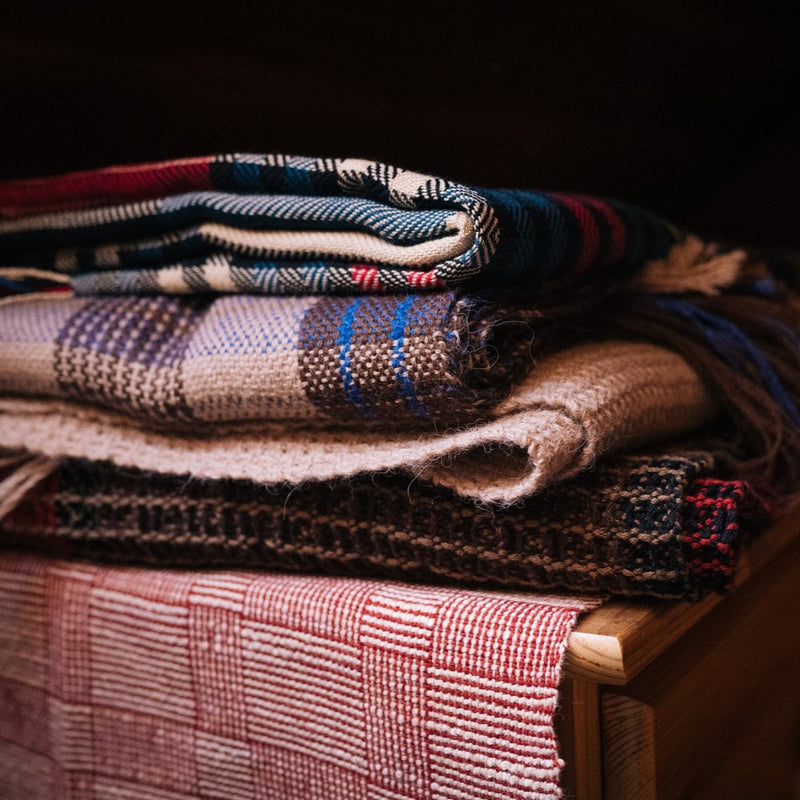What's included in your Gather Weave Online membership:
-

Learn to weave with our beginner weaving course.
Our beginner weaving course starts from the very beginning and teaches the basics of project planning, dressing your loom, and weaving.
-
Intermediate and advanced weaving courses.
Ready to learn how to weave in fancy twills? Try overshot? Waffle Weave? Understand all about weaving yarn? We make it easy to build the skills you need to make your dream project.
-

Full access to all of our weaving patterns.
Need inspiration? Explore and weave with our library of weaving patterns, perfect for all levels.
-

Weave Online member exclusive newsletter.
Stay informed and inspired with a monthly newsletter featuring the latest happenings at Gather. We will highlight new patterns, share tips, tricks and inspiration, and tell you all about what we are making behind the scenes.
-

Get 15% off weaving kits.
Get everything you need to start your next project with a 15% discount on our weaving kits.
-

Exclusive sales and offers.
Benefit from exclusive sales and offers available only to members of Gather Weave Online.
Learn to Weave from Master Weavers
Take our beginner course to learn the basics or dive into an advanced course to learn complex structures.
Explore our weaving courses.
Membership Includes Access to All of Our Weaving Patterns and 15% Off Kits!
View AllStart weaving today.
Full access to Gather Weave Online starting at USD $10 / month, billed annually. 7-day money back guaranteed.

Why Learn With Us?
At Gather we believe weaving doesn't need to be intimidating.
Yes there are lots of steps and a gigantic history of weaving to be inspired by... but that's the fun of it! We're excited to bring you into the fold as you build your own weaving practice and enjoy all the beautifully tactile results. Our weaving courses are designed for all levels, providing expert guidance, personalized feedback, and a nerdy weaving enthusiasm.
Interested in Rigid Heddle Weaving?
Frequently Asked Questions
General
What is Gather Weave Online?
What is Gather Weave Online?
Gather Weave Online is an all-in-one membership designed for weavers of all skill levels. It provides access to a wide range of weaving courses, resources, and tools to help you learn, build your skills, and enjoy weaving! Whether you're a beginner or an experienced weaver, you'll find expert guidance, engaging projects, and a supportive community here.
What is included in my membership?
What is included in my membership?
Your Gather Weave Online membership includes: Full access to all online courses, including a beginner weaving series. A comprehensive library of weaving patterns. Exclusive discounts on weaving kits and supplies. A monthly newsletter with inspiration, tips, and updates. Invitations to exclusive sales and events.
Where can I buy weaving supplies to go with my membership?
Where can I buy weaving supplies to go with my membership?
You can purchase weaving supplies, including yarn, tools, and weaving kits at our online store: www.gathertextiles.com. As a member you'll also enjoy exclusive discounts on selected products.
Pricing & Payment
How much does Gather Weave Online cost?
How much does Gather Weave Online cost?
Membership costs USD$10/month, billed annually (USD$119/year).
Why is the Gather Weave Online membership priced in USD?
Why is the Gather Weave Online membership priced in USD?
We understand this might be surprising for our Canadian customers. Unfortunately the membership platform we’re using only supports pricing in one currency and USD was chosen to accommodate our global weaving community. We tried everything we could do to offer Weave Online in both USD and CAD but the technology wouldn’t allow it. We are hopeful that the platform’s technology will evolve to allow for CAD pricing in the future as this is important to us as a Canadian company. We’d like to assure you that this ONLY applies to the Weave Online membership. All purchases made on gathertextiles.com continue to be billed in your local currency (CAD for Canadians).
How do I cancel my membership?
How do I cancel my membership?
You can cancel your membership at any time through your account settings on the Gather Weave Online platform. Once cancelled, your membership will remain active until the end of your current billing cycle. Please see our Gather Weave Online Membership Policy for full details.
How does the 7-day money back guarantee work?
How does the 7-day money back guarantee work?
We are confident you will love Gather Weave Online so we offer a 7 day money back guarantee. If you are not totally satisfied with your Gather Weave Online membership, please contact us and we'll offer a full refund. Full details are here.




















